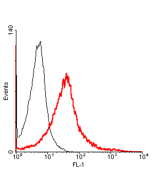Cookie Policy: This site uses cookies to improve your experience. You can find out more about our use of cookies in our Privacy Policy. By continuing to browse this site you agree to our use of cookies.
Chimerigen
Tim-3 (mouse):Fc (mouse) (rec.)

| Product Details | |
|---|---|
| Synonyms | TIM3; TIMD3; Hepatitis A Virus Cellular Receptor 2; HAVcr-2; T Cell Immunoglobulin and Mucin Domain-containing Protein 3 |
| Product Type | Protein |
| Properties | |
| Source/Host | HEK 293 cells |
| Sequence |
The extracellular domain of mouse Tim-3 (aa 21-189) is fused to the N-terminus of the Fc region of mouse IgG2a. |
| Crossreactivity | Mouse |
| Biological Activity |
Immobilized recombinant human Galectin-9 at 500ng/ml can bind Tim-3 (mouse):Fc (human) (rec.) with an apparent KD <10nM. Optimal dilutions should be determined by each laboratory for each application. |
| MW | ~65kDa (SDS-PAGE) |
| Purity | ≥98% (SDS-PAGE) |
| Endotoxin Content | <5EU/mg protein (LAL test; Lonza). |
| Reconstitution | Reconstitute with 100 µl sterile water. Add 1X PBS to the desired protein concentration. |
| Accession Number | AAI06852.1 |
| Formulation | Lyophilized from 0.2μm-filtered solution in PBS. |
| Protein Negative Control | |
| Other Product Data |
NCBI reference AAI06852.1: Tim-3 (mouse) |
| Declaration | Manufactured by Chimerigen. |
| Shipping and Handling | |
| Shipping | BLUE ICE |
| Short Term Storage | +4°C |
| Long Term Storage | -20°C |
| Handling Advice |
Avoid freeze/thaw cycles. Centrifuge lyophilized vial before opening and reconstitution. |
| Use/Stability |
Stable for at least 1 year after receipt when stored at -20°C. Working aliquots are stable for up to 3 months when stored at -20°C. |
| Documents | |
| Product Specification Sheet | |
| Datasheet |
 Download PDF Download PDF |
The TIM (T cell/transmembrane, immunoglobulin and mucin) family plays a critical role in regulating immune responses, including allergy, asthma, transplant tolerance, autoimmunity and the response to viral infections. The unique structure of TIM immunoglobulin variable region domains allows highly specific recognition of phosphatidylserine (PtdSer), exposed on the surface of apoptotic cells. Tim-3, a type I transmembrane protein, contains an immunoglobulin and a mucin-like domain in its extracellular portion and a tyrosine phosphorylation motif in its cytoplasmic portion. TIM-3 is preferentially expressed on Th1 and Tc1 cells, and generates an inhibitory signal resulting in apoptosis of Th1 and Tc1 cells. TIM-3 is also expressed on some dendritic cells and can mediate phagocytosis of apoptotic cells and cross-presentation of antigen. Tim-3 functions to inhibit aggressive Th1-mediated auto- and alloimmune responses. Tim-3 pathway blockade by administration of Tim-3:Fc fusion protein accelerates diabetes in nonobese diabetic mice, causes hyperproliferation of Th1 cells and Th1 cytokine release in an experimental autoimmune encephalomyelitis (EAE) model and prevents acquisition of transplantation tolerance induced by costimulation blockade.
- Interaction of Tim-3 and Tim-3 ligand regulates T helper type 1 responses and induction of peripheral tolerance: C.A. Sabatos, et al.; Nat. Immunol. 4, 1102 (2003)
- The Tim-3 ligand galectin-9 negatively regulates T helper type 1 immunity: C. Zhu, et al.; Nat. Immunol. 6, 1245 (2005)
- TIM-3 is expressed on activated human CD4+ T cells and regulates Th1 and Th17 cytokines: W.D. Hastings, et al.; Eur. J. Immunol. 39, 2492 (2009)







